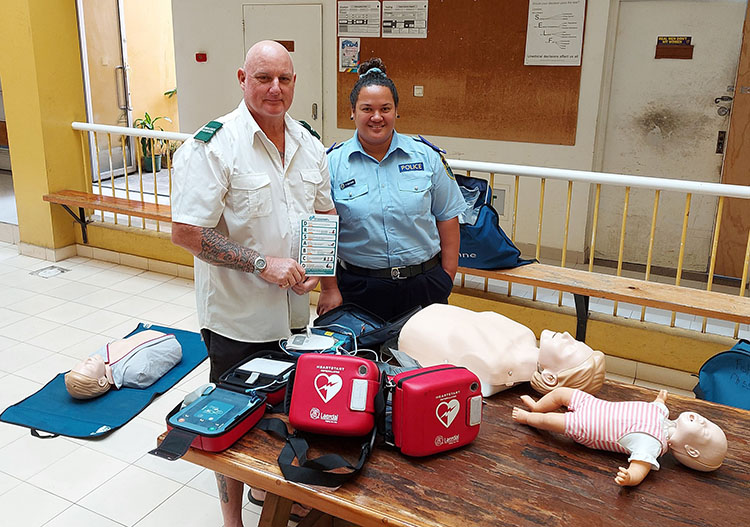Fisher emphasises correct use of defibrillator
Tuesday 7 September 2021 | Written by Alana Musselle | Published in Health, National

Brent Fisher instructing a police officer in basic first aid. An automated external defibrillator at Raemaru Park in Arorangi was discovered stolen on Friday. 21071403
Recognising the important of both CPR and Automated External Defibrillators (AED) has been emphasised by the Water Safety Cook Islands president Brent Fisher.
Fisher approached Cook Islands News after a recent incident where an individual passed away even after attempts to revive him through the use of CPR and AED.
He wanted to explain how failure to revive someone through these devices “does not mean that they are ineffective”.
Automated External Defibrillators are designed for anyone to use regardless if they have been formally trained on their operations. People can operate this through voice instructions, pictures, and prompts. An AED will only deliver a shock if indicated and is safe, when used correctly.
In the incident reported to Fisher, both CPR and AED were used in an attempt to revive the individual. Although those on the scene did everything correctly, the man passed away.
Fisher, who has held several instructing sessions for the public on how to perform CPR and how to use defibrillators, said: “The most important thing in these situations is to get there as soon as possible. What happens sometimes, there is no shockable rhythm in the heart and so when this happens you need to keep doing CPR. By doing that you can get the heart rhythm going again.”
“The people there did everything right. It is just important for the public to know that even if a defibrillator does not emit a shock, it does not mean it is faulty, and you must always attempt to continue to revive a person through CPR as well.”
According to an online link (www.firstaidforfree.com) sent to Cook Islands News by Fisher, AED’s function by taking an electrocardiogram of the victim’s heart to analyse the electrical activity in an attempt to determine if the victim is in Ventricular Fibrillation (VF) or another heart rhythm.
If the AED analysis indicated VF, a shock will be indicated and may be delivered by the rescuer and AED, according to the device’s operating instructions. If the AED analysis finds any other rhythm than VF a “no shock” instruction will be issued and the AED will not allow a shock to be delivered.
The placement of the AED pads on the patient’s body are important also, Fisher said. AED pads typically go around the heart and are placed on the upper right side of the chest below the collar bone and on the lower left side below the nipple line near the armpit. The electricity delivered by an AED will travel in both directions between these two pads.
Rescuers using an AED must always listen to the instructions of an AED. The AED will advise not to touch the patient while it is analysing the victim’s heart and again if a shock is indicated. If the victim is touched or moved during analysis, the AED may interrupt those movements and cause a potential false positive for V-Fib. If any person is touching the victim when a shock is actually delivered, they may receive some of the shock which may cause injury or even death.
If you are operating an AED, verbally yell and physically look head to toe to make sure no person is touching the victim when the AED advises not to touch the victim
An AED does not restart the heart or fix a “flat line” as often shown on television. A flat line represents that there is no heart electrical activity at all. A flat line usually represents clinical death as it is rare to recover from a flat line rhythm. If an AED recognises a “flat line” it will indicate “no shock advised” and instruct you to resume CPR.
If a shock is indicated and delivered, the heart may take up to 10 minutes to recover from the cardiac arrest. Therefore, immediately after delivering a shock (or a “No Shock” indication) the rescuers must resume CPR with compressions to help mechanically get the heart beating again. Effectiveness of a shock is greatly affected by how well CPR is performed immediately thereafter.
Once an AED is placed, never remove the pads from the victim's chest or turn the AED off until instructed to by trained healthcare professionals. If the victim wakes up or recovers, they may suffer from VF again and require additional AED treatment.
Fisher said: “Early and good CPR and good use of the AED usually equals a good result.”
- Additional reporting by First Aid For Free














































